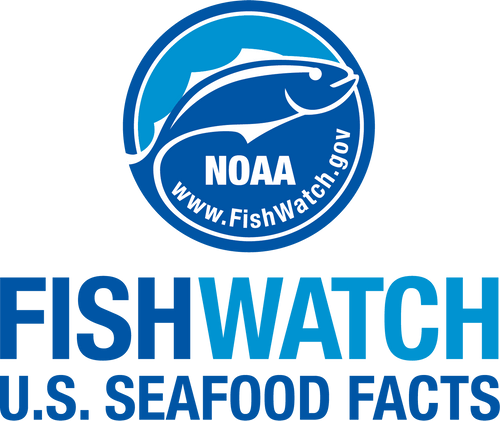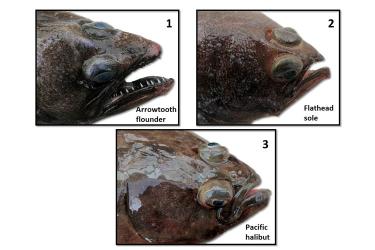 Yellowfin sole. Credit: NOAA Fisheries
Yellowfin sole. Credit: NOAA Fisheries
Yellowfin sole. Credit: NOAA Fisheries
About the Species
 Yellowfin sole. Credit: NOAA Fisheries
Yellowfin sole. Credit: NOAA Fisheries
Yellowfin sole. Credit: NOAA Fisheries
U.S. wild-caught yellowfin sole is a smart seafood choice because it is sustainably managed and responsibly harvested under U.S. regulations.

Population
The Bering Sea/Aleutian Islands stock is not overfished.

Fishing Rate
Not subject to overfishing.

Habitat Impact
Area closures and gear restrictions protect habitats affected by bottom trawls used to harvest yellowfin sole.

Bycatch
Regulations are in place to minimize bycatch.
Population Status
- There are two stocks of yellowfin sole: one in the Bering Sea/Aleutian Islands and one in the Gulf of Alaska Shallow Water Flatfish Complex. According to the most recent stock assessments:
- The Bering Sea/Aleutian Islands stock is not overfished (2022 stock assessment) and not subject to overfishing based on 2022 catch data. Summary stock assessment information can be found on Stock SMART.
- Yellowfin sole is managed as part of the Gulf of Alaska Shallow Water Flatfish Complex, but has not been assessed. The complex is not overfished based on the stock assessment of Northern rock sole - Central Gulf of Alaska (2021 stock assessment), Northern rock sole - Western Gulf of Alaska (2021 stock assessment), rock sole - Central Gulf of Alaska (2021 stock assessment), and rock sole - Western Gulf of Alaska (2021 stock assessment) which are regarded as the primary indicator species in this complex. The stock complex is not subject to overfishing based on 2023 catch data. Summary stock assessment information for Northern rock sole - Central Gulf of Alaska can be found on Stock SMART, Northern rock sole - Western Gulf of Alaska can be found on Stock SMART, rock sole - Central Gulf of Alaska can be found on Stock SMART, and rock sole - Western Gulf of Alaska can be found on Stock SMART.
Appearance
- Yellowfin sole are a flatfish with a small mouth and moderately large eyes that are both on one side of their body.
- Their body shape is generally round with rounded edges on the tail fin.
- Their upper side is olive to dark brown with dark mottling, and their underside is pale.
- Yellowfin sole are named for their yellowish fins. Their fins also have faint dark bars and a narrow dark line at their base.
- Their anal spine is thin, sharp, and exposed.
- They have rough scales on both sides of the body.
Biology
- Yellowfin sole grow up to more than 1.5 feet long and can live up to 39 years.
- Most females are able to reproduce when they reach 10.5 years old, or when they’re about 1 foot long.
- They spawn in the spring and summer in shallow waters on the inner continental shelf. Females produce between 1 and 3 million eggs.
- Larvae and early juveniles eat plankton and algae. Late juveniles and adults eat bivalves, worms, amphipods, mollusks, krill, shrimp, brittle stars, sculpins, and other crustaceans.
- Pacific cod and halibut prey on juvenile yellowfin sole.
Where They Live
Range
- In the United States, yellowfin sole are found in the North Pacific Ocean from British Columbia up to the Chukchi Sea (north of the Bering Sea).
Habitat
- Yellowfin sole live on soft, sandy ocean bottoms on the eastern Bering Sea Shelf.
Fishery Management
- NOAA Fisheries and the North Pacific Fishery Management Council manage the yellowfin sole fishery.
- Managed under the Fishery Management Plan for Groundfish of the Bering Sea/Aleutian Islands:
- Permits are required, and the number of available permits is limited to control the amount of fishing.
- Managers set an annual catch limit for yellowfin sole.
- A percentage of the catch limit is allocated to the community development quota program, which benefits fishery-dependent communities in Western Alaska. The rest is allocated among the various fishing sectors based on gear type, vessel size, and ability to process their catch.
- All yellowfin sole caught must be retained for processing.
- Catch is monitored through record keeping, reporting requirements, and observer coverage.
- Managed under the Fishery Management Plan for Groundfish of the Gulf of Alaska:
- Yellowfin sole is included under this fishery management plan, but only a very small amount is incidentally caught in this area.
Harvest
- In 2023, commercial landings of yellowfin sole totaled 245 million pounds, and were valued at $42 million, according to the NOAA Fisheries commercial fishing landings database.
- Gear types, habitat impacts, and bycatch:
- Bottom trawls are used to catch yellowfin sole.
- Trawls that are used to harvest yellowfin sole can contact the ocean floor and impact habitats, depending on the makeup of the ocean bottom and the size of the gear.
- Bottom trawls cause minimal damage to habitat when targeting yellowfin sole over soft, sandy, or muddy ocean bottoms in Alaska.
- NOAA Fisheries and the North Pacific Fishery Management Council have implemented large closed areas to protect sensitive habitats from bottom trawls.
- Vessel monitoring systems allow enforcement staff and fishery managers to monitor GPS locations of fishing activities to ensure vessels are complying with closed areas.
- There are limits on the amount of halibut and crab that groundfish fisheries can incidentally catch. If the limit is reached, managers close the fishery for the remainder of the season to minimize bycatch.
Scientific Classification
- In the United States, yellowfin sole are found in the North Pacific Ocean from British Columbia up to the Chukchi Sea (north of the Bering Sea).
- Yellowfin sole live on soft, sandy ocean bottoms on the eastern Bering Sea Shelf.
Fishery Management
- NOAA Fisheries and the North Pacific Fishery Management Council manage the yellowfin sole fishery.
- Managed under the Fishery Management Plan for Groundfish of the Bering Sea/Aleutian Islands:
- Permits are required, and the number of available permits is limited to control the amount of fishing.
- Managers set an annual catch limit for yellowfin sole.
- A percentage of the catch limit is allocated to the community development quota program, which benefits fishery-dependent communities in Western Alaska. The rest is allocated among the various fishing sectors based on gear type, vessel size, and ability to process their catch.
- All yellowfin sole caught must be retained for processing.
- Catch is monitored through record keeping, reporting requirements, and observer coverage.
- Managed under the Fishery Management Plan for Groundfish of the Gulf of Alaska:
- Yellowfin sole is included under this fishery management plan, but only a very small amount is incidentally caught in this area.
Harvest
- In 2023, commercial landings of yellowfin sole totaled 245 million pounds, and were valued at $42 million, according to the NOAA Fisheries commercial fishing landings database.
- Gear types, habitat impacts, and bycatch:
- Bottom trawls are used to catch yellowfin sole.
- Trawls that are used to harvest yellowfin sole can contact the ocean floor and impact habitats, depending on the makeup of the ocean bottom and the size of the gear.
- Bottom trawls cause minimal damage to habitat when targeting yellowfin sole over soft, sandy, or muddy ocean bottoms in Alaska.
- NOAA Fisheries and the North Pacific Fishery Management Council have implemented large closed areas to protect sensitive habitats from bottom trawls.
- Vessel monitoring systems allow enforcement staff and fishery managers to monitor GPS locations of fishing activities to ensure vessels are complying with closed areas.
- There are limits on the amount of halibut and crab that groundfish fisheries can incidentally catch. If the limit is reached, managers close the fishery for the remainder of the season to minimize bycatch.
Scientific Classification
| Kingdom | Animalia | Phylum | Chordata | Class | Actinopterygii | Order | Pleuronectiformes | Family | Pleuronectidae | Genus | Limanda | Species | aspera |
|---|
Last updated by NOAA Fisheries on 03/21/2025
Featured News
 The research vessel Norseman II pushes carefully through the ice, maneuvering for open water. Credit: Gavin M Brady/NOAA Fisheries.
The research vessel Norseman II pushes carefully through the ice, maneuvering for open water. Credit: Gavin M Brady/NOAA Fisheries.
 Offloading frozen Pacific cod from a catcher-processor vessel in Dutch Harbor, Alaska. Credit: NOAA Fisheries / Paul Hillman.
Offloading frozen Pacific cod from a catcher-processor vessel in Dutch Harbor, Alaska. Credit: NOAA Fisheries / Paul Hillman.
Economic Snapshot Shows Alaska Seafood Industry Suffered $1.8 Billion Loss 2022–2023
 3D render and imaging of topographic map of Alaska showing the Gulf of Alaska, Aleutian Islands and Bering Sea. Satellite images courtesy of NASA. Credit: Frank Ramspott
3D render and imaging of topographic map of Alaska showing the Gulf of Alaska, Aleutian Islands and Bering Sea. Satellite images courtesy of NASA. Credit: Frank Ramspott
 Alaska pollock. Credit: NOAA Fisheries.
Alaska pollock. Credit: NOAA Fisheries.
Tracking Climate-Driven Shifts in Fish Populations Across International Boundaries
Seafood Facts

Is Yellowfin Sole Sustainable?
U.S. wild-caught yellowfin sole is a smart seafood choice because it is sustainably managed and responsibly harvested under U.S. regulations.
Availability
Year-round.
Source
U.S. wild-caught from Alaska.
Taste
Mild, sweet flavor.
Texture
Firm and delicate with small flakes.
Color
Meat is cream colored.
Health Benefits
Yellowfin sole is an excellent source of low-fat protein and calcium.
Nutrition Facts
Servings: 1; Serving Weight: 100 g; Calories: 91; Protein: 18.84 g ; Total Fat: 1.19 g; Total Saturated Fatty Acids: 0.283 g; Carbohydrate: 0 g; Total Sugars: 0 g; Total Dietary Fiber: 0 g; Cholesterol: 48 mg; Selenium: 32.7 mcg; Sodium: 81 mgMore Information
Sole Recipes
Looking for some ways to add sole into your rotation? If you need some cooking inspiration, browse these recipes for citrus sole with tahini drizzle, sole sliders, and more!

Last updated by NOAA Fisheries on 03/21/2025
Seafood News
 Chef Tyler Hadfield’s Curried Skate Wings with Tomato-Masala Chutney
Chef Tyler Hadfield’s Curried Skate Wings with Tomato-Masala Chutney
Ring In the New Year With These Crowd-Favorite Seafood Recipes
 NOAA Fisheries, in collaboration with Blue Ocean Mariculture, is conducting a multi-year pilot study to evaluate observational methods and tools for studying Hawaiian monk seal behavior. Courtesy of Blue Ocean Mariculture
NOAA Fisheries, in collaboration with Blue Ocean Mariculture, is conducting a multi-year pilot study to evaluate observational methods and tools for studying Hawaiian monk seal behavior. Courtesy of Blue Ocean Mariculture
AI Meets Aquaculture to Study Hawaiian Monk Seal Interactions With Net Pens
 Tonya Wick aboard a fishing vessel at sea in 1998. Photo courtesy of Tonya Wick
Tonya Wick aboard a fishing vessel at sea in 1998. Photo courtesy of Tonya Wick
 Fish on display at the market. Credit: Shutterstock
Fish on display at the market. Credit: Shutterstock
Science Overview

NOAA Fisheries conducts various research activities on the biology, behavior, and population health of yellowfin sole. The results of this research are used to inform management decisions for this species.
For detailed information about stock status, management, assessments, and resource trends, you can search for yellowfin sole, and any other species of interest, using NOAA’s StockSMART web tool.
Yellowfin Sole Research in Alaska
Yellowfin sole is one of the most abundant flatfish species in the eastern Bering Sea and a target of the largest flatfish fishery in the United States. It is found in North American waters from British Columbia to the Chukchi Sea and as far south as the Sea of Japan.
Studying Age and Growth
Our research has focused on the study of yellowfin sole growth, reproduction, diet, distribution, and juvenile habitat. We have learned that this fish is slow-growing, reaching up to 45 cm in length and 39 years of age. Males become reproductive at about age 7 and females at about age 10, with females producing from 300,000 to 3.6 million eggs.
Identifying Essential Yellowfin Sole Habitats
Adults undergo annual spawning migrations of more than 500 km (1000 km round trip) from wintering grounds west and southeast of the Pribilof Islands to nearshore summer spawning grounds in Kuskokwim and Bristol bays. Juveniles live in shallow coastal waters and feed on small animals that live on or in the sandy sea bottom, mostly polychaetes (bristle) worms, shrimp-like amphipods, and clams.
Tracking the Impacts of Environmental Conditions
Yellowfin sole are most abundant on the eastern Bering Sea shelf, where annual long-term research surveys have shown biomass to exceed 2 million tons over most years dating back to 1982. Research associated with these surveys has shown that yellowfin summer distributions differ among years depending on bottom temperatures which affect the timing of the yellowfin sole spawning migrations.
Last updated by NOAA Fisheries on 03/21/2025
Documents
2018 Status of Alaska Marine Ecosystems Considerations - Eastern Bering Sea Report in Brief
The eastern Bering Sea was characterized by anomalously warm conditions in 2018. Over the northern…
Regulatory Impact Review/Environmental Assessment for Amendment 116 to the Fishery Management Plan for the Groundfish of the Bering Sea and Aleutian Islands Management Areas
This document analyzes proposed management measures that would limit access for trawl catcher…
Amendment 80 Checklist
Small Entity Compliance Guide for the Amendment 80 Groundfish Trawl Fisheries.
Supplemental Environmental Assessment/Regulatory Impact Review/Final Regulatory Flexibility Analysis for Amendment 75 to the Fishery Management Plan for Groundfish of the Bering Sea and Aleutian Islands Area - Changes in IR/IU Flatfish Requirements
Analysis of alternative actions to address the issue of the improved retention and improved…
Data & Maps
2024 Gulf Of Alaska Ecosystem Status Report: In Brief
This assessment summarizes and synthesizes climate, biological, and fishing effects on the shelf…
Ecosystem Status Report 2024 Gulf of Alaska
This assessment summarizes and synthesizes climate, biological, and fishing effects on the shelf…
2024 Aleutian Islands Ecosystem Status Report: In Brief
This assessment summarizes and synthesizes historical climate and fishing effects on the shelf and…
Ecosystem Status Report 2024 Aleutian Islands
This assessment summarizes and synthesizes historical climate and fishing effects on the shelf and…
Research
2023 North Pacific Groundfish Stock Assessments
2023 North Pacific Groundfish Stock Assessment and Fishery Evaluation Reports for 2024 Fisheries
2022 North Pacific Groundfish Stock Assessments
2022 North Pacific Groundfish Stock Assessment and Fishery Evaluation Reports for 2023 Fisheries
North Pacific Groundfish Stock Assessments and Fishery Evaluation Reports
Alaska Groundfish Stock Assessments, Economic Status Reports, and Ecosystem Status Reports.
2021 North Pacific Groundfish Stock Assessments
2021 North Pacific Groundfish Stock Assessment and Fishery Evaluation Reports for 2022 Fisheries
Last updated by NOAA Fisheries on 03/21/2025






